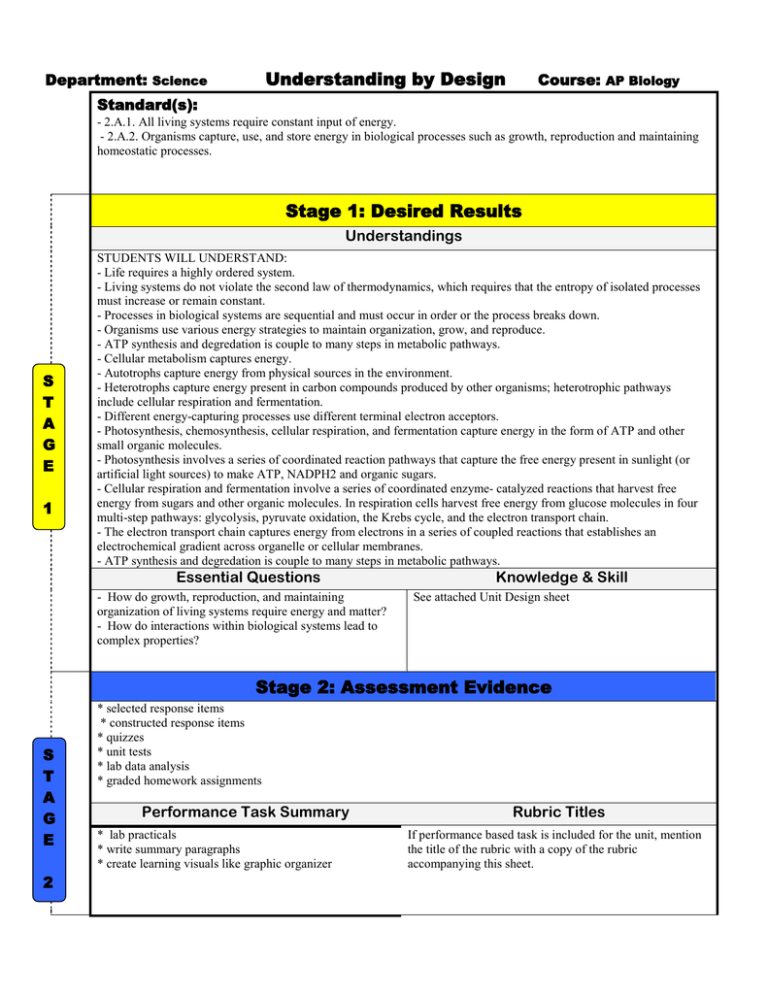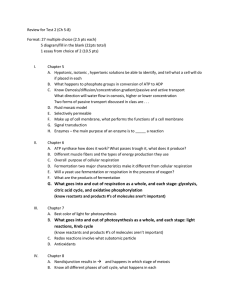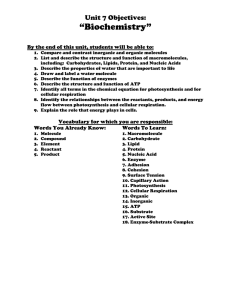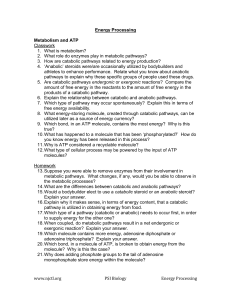Cellular Energetics
advertisement

Understanding by Design Department: Science Course: AP Biology Standard(s): - 2.A.1. All living systems require constant input of energy. - 2.A.2. Organisms capture, use, and store energy in biological processes such as growth, reproduction and maintaining homeostatic processes. Stage 1: Desired Results Understandings S T A G E 1 STUDENTS WILL UNDERSTAND: - Life requires a highly ordered system. - Living systems do not violate the second law of thermodynamics, which requires that the entropy of isolated processes must increase or remain constant. - Processes in biological systems are sequential and must occur in order or the process breaks down. - Organisms use various energy strategies to maintain organization, grow, and reproduce. - ATP synthesis and degredation is couple to many steps in metabolic pathways. - Cellular metabolism captures energy. - Autotrophs capture energy from physical sources in the environment. - Heterotrophs capture energy present in carbon compounds produced by other organisms; heterotrophic pathways include cellular respiration and fermentation. - Different energy-capturing processes use different terminal electron acceptors. - Photosynthesis, chemosynthesis, cellular respiration, and fermentation capture energy in the form of ATP and other small organic molecules. - Photosynthesis involves a series of coordinated reaction pathways that capture the free energy present in sunlight (or artificial light sources) to make ATP, NADPH2 and organic sugars. - Cellular respiration and fermentation involve a series of coordinated enzyme- catalyzed reactions that harvest free energy from sugars and other organic molecules. In respiration cells harvest free energy from glucose molecules in four multi-step pathways: glycolysis, pyruvate oxidation, the Krebs cycle, and the electron transport chain. - The electron transport chain captures energy from electrons in a series of coupled reactions that establishes an electrochemical gradient across organelle or cellular membranes. - ATP synthesis and degredation is couple to many steps in metabolic pathways. Essential Questions - How do growth, reproduction, and maintaining organization of living systems require energy and matter? - How do interactions within biological systems lead to complex properties? Knowledge & Skill See attached Unit Design sheet Stage 2: Assessment Evidence S T A G E 2 * selected response items * constructed response items * quizzes * unit tests * lab data analysis * graded homework assignments Performance Task Summary * lab practicals * write summary paragraphs * create learning visuals like graphic organizer Rubric Titles If performance based task is included for the unit, mention the title of the rubric with a copy of the rubric accompanying this sheet. Self-Assessments * Unit test corrections * Student graded homework * Review of "I Can" statements. Other Evidence, Summarized Other assessment information will be obtained through observations, classroom participation, class discussion and interactions, and scaffold learning, as well as data collected through Mastery Manager. Stage 3: Learning Activities S T A G E 3 - AP Lab 2 Enzyme Catalysis - AP Lab 4 Plant Pigments and Photosynthesis - AP Lab 5 Cell Respiration




